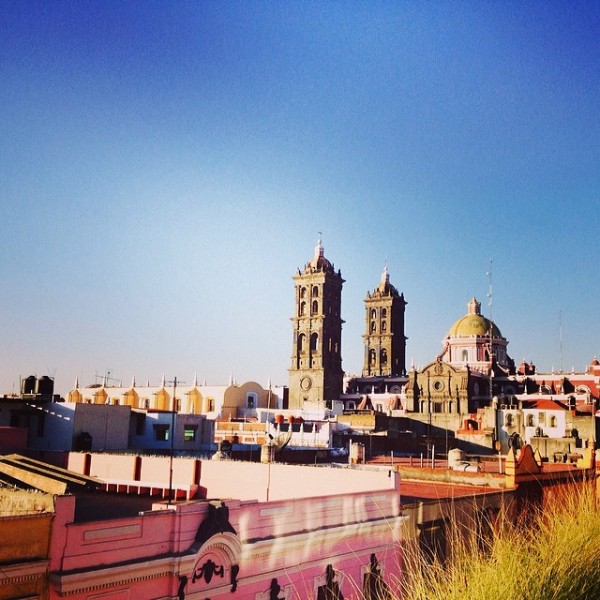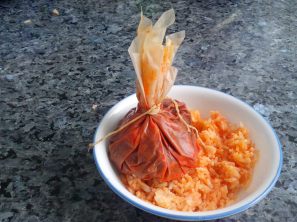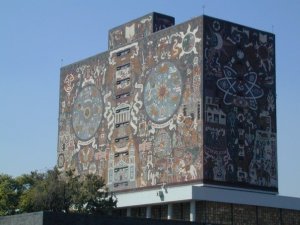It has a nearly 500 year old cathedral. Its historic center is a UNESCO World Heritage Site. A minor battle, fought on May 5, 1862, took place there (hint: this is why we celebrate Cinco de Mayo). There is a town close by with a major pyramid. It’s only two hours from the Gulf of Mexico and five from the Pacific. There are four volcanoes surrounding the city and a spectacular world class museum. It’s clean, beautiful, and a mere two hours by very comfortable buses from Mexico City, recently described by the New York Times as the top city to visit in 2016.
Tag Archives: Mexico
The Mixiote: An Indigenous Culinary Delight
I began my second quarter century on this rock on March 30, and on Saturday the 29th we had a party at my house here in Puebla to celebrate (besides my birthday we were also belatedly celebrating both my brother’s graduation from college back in summer 2012 and my January graduation from law school). We had family, longtime friends, and people we’ve become close to more recently attend, and it was a blast. We also prepared one of my favorite dishes of any cuisine ever: the mixiote.
Mixiote (pronounced meesh-EEOH-teh) is a word in Nahuatl (NAH-ooah-tl), the language of the Mexica people more commonly known by their Spanish name: the Aztecs. As a side note, the word “Mexico” comes from the word “Mexica”, which explains the country’s name. In any case, variations on Nahuatl are still spoken by 1.45 million people in Mexico according to a 2005 report of the Instituto Nacional de Estadistica y Geografia (“INEGI”), the Mexican government’s statistics bureau. Many words in English are originally Nahuatl, including avocado (aguacate in Spanish, ahuacatl in Nahuatl), chili peppers (chile in Spanish, chilli in Nahuatl), chocolate (chocolate in Spanish, chocolatl in Nahuatl), coyote (coyote in Spanish, coyotl in Nahuatl), and many more. Culturally, most Mexicans use words derived from Nahuatl every day, often without even knowing that is where they come from. Ethnically, almost all Mexicans are mestizos—of mixed European and indigenous bloodlines—with many of us from the Valley of Mexico having Mexica ancestry. Personally I’m unsure if I have Mexica blood, but my family has Zapotec and other indigenous groups in our ethnic mix.
The Pyramid of the Sun: How Much Longer Will It Last?
As you may have seen earlier, I posted my first blog post in Spanish. As promised here is the English version, but I wanted to get the other one out first. As you can see from the title, a study done by physicists at the National Autonomous University of Mexico (“UNAM” by its Spanish acronym) recently came to my attention. The study says that the Pyramid of the Sun, the archeological site of Teotihuacan, Mexico, may be on the verge of collapse. In short, the problem seems to be that one side of the pyramid has much more humidity than the other, causing an imbalance in the structure. This matters because unlike the pyramids in Egypt and others, the Pyramid of the Sun is not built of solid rock, but is instead filled with soil.
After looking at the study and consulting a friend who is a physicist who graduated from the UNAM, I decided to publish a brief piece about the problem. The Pyramid of the Sun is one of the most impressive structures I’ve seen, and it would be a real tragedy for Mexico—and for humanity—if it collapsed. It is part of a UNESCO World Heritage Site, and I hope that organization becomes involved and helps solve the problem.
As I understand it, scientists are not sure how to save the pyramid. Some believe that they have to add more humidity to the dry side, while others believe that the humid side is too humid. This is because cement has been added at various times to firm up the structure, and that could be holding water in. As I really don’t know anything about the issue, I won’t wade into the debate, but I do expect—and as a citizen of the world I ask—that scientists resolve this issue quickly and safe the magnificent structure that is the Pyramid of the Sun.
But while this is resolved—go to Teotihuacan! It’s a great place to visit no matter what. And while hopefully nothing will happen to the pyramid, it’s worth making the journey there one more time.
La Pirámide del Sol: ¿Cúanto más nos dura?
¡Hola!
Pues por primera ves voy a escribir una entrada en el blog en español. También lo traduciré, pero por ahora vamos a publicar el que está en español. Como pueden ver del título, recientemente atrajo mi atención un estudio realizado por físicos de la Universidad Nacional Autónoma de México (“UNAM”) que dice que la Pirámide del Sol, en Teotihuacan, México, está en riesgo de colapsarse. En breve, el problema parece ser que de un lado hay mucha más humedad que del otro, llevando a una falta de balance en la estructura. Esto es importante porque, a diferencia de las pirámides en Egipto o en otras partes, la Pirámide del Sol no está construida de piedra sólida, sino que viene rellena de pura tierra.
Después de ver el estudio y hacerle unas preguntas a un amigo que es físico graduado de la UNAM, decidí publicar algo corto sobre el problema, ya que la Pirámide del Sol es una de las estructuras arquitectónicas más interesantes que he visto en mi vida. Sería realmente una tragedia para México—y para la humanidad—si se derrumbara la pirámide. Es Patrimonio de la Humanidad de la UNESCO, y espero que la organización internacional se involucre para resolver el problema.
Según entiendo, los científicos no están seguros de cómo salvar a la pirámide. Algunos creen que hay que humedecer el lado seco, mientras que otros piensan que el lado húmedo está demasiado húmedo porque el cemento que se ha usado para sellar algunas partes de la estructura no deja salir el agua. No teniendo ni la menor idea de cómo funciona esto, no me meto en el debate, pero si espero—y como ciudadano del mundo pido—que resuelvan su disputa pronto y salven a la magnifica Pirámide del Sol.
Pero mientras—¡vayan a Teotihuacan! Ojalá no pase nada, pero si sí, hay que haber hecho el viaje por lo menos una ves más a una de las estructuras más impresionantes del mundo.
From Puebla to London in 72 Hours: Via Mexico City, Houston, D.C., and Copenhagen
It’s been a whirlwind few weeks for sure. On Tuesday morning July 2, 2013, around 10:00 I left Puebla, Mexico, the bustling city of three million where my parents live, to head to Oxford, UK, for my month long course in human rights law. A two hour bus ride to Mexico City later, I was sitting in Terminal One, the old terminal, of the Benito Juarez International Airport. Two hours after getting on that plane, I landed in Houston’s George Bush International Airport, went through immigration, customs, rechecked my bag, and boarded the second plane of the day, to Washington D.C.’s Reagan National. By the time I finally got to bed around 1:00 am, I was pretty out of it. Wednesday I saw friends, did errands, went to my therapist, and repacked. Thursday afternoon I boarded a SuperShuttle out to Dulles International Airport, another one of D.C.’s three, to board my Scandinavian Airways flight to London, via Copenhagen, Denmark. I’d decided to give myself a longer layover there to get a short glimpse of the city. Having never been to Scandinavia, I wanted to have a chance to at least walk the streets and eat some food. I checked my bag all the way through to London, and with my small trusty backpack took the Copenhagen metro into the heart of the city. I’ve written about that already, but I wanted to just give a little recap of those days.
When I finally arrived at Heathrow Airport later that Friday (July 5), the immigration line took close to two hours, and then the Tube ride into the city (I got off at the Warwick Avenue station, close to Paddington) took an eternity. When I arrived, my friend had already left his apartment to stay with his parents in the country (I arrived hours later than expected). Someone in the street lent me their phone (they turned out to be Spaniards living in London), and I called my friend. I was able to meet him at Paddington to go out to the town of Newbury, close to where his family is. When I finally arrived there it was after 21:00. I met his family, we had dinner, and talked a lot until about midnight GMT, and then headed to bed to be able to wake up early to go to the Henley Royal Regatta, which was quite something. In short, it was rather hectic 72 hours, but it’s been incredibly worth it—seeing friends, going to events, being in Oxford studying human rights, and meeting new people has been amazing.
The idea of this post is to kind of make it an introduction to the rest of the entries I will put up while in Europe. One is in the planning called British Sports: Lions and Murray and Henley, Oh My! and others will be organized around different topics (the visit to Blenheim Palace, the course work, other trips, and of course the wonderful city of Oxford itself). I’m also going to write about other issues I deal with here. While it’s been a busy time, and the human rights law program keeps you on your toes, I think I can slip in a few posts here and there, although perhaps with less detail and links than my usual ones. Let’s see how it goes!



